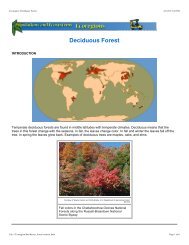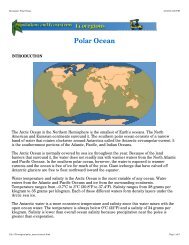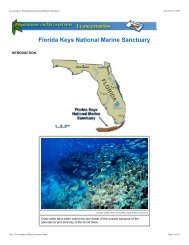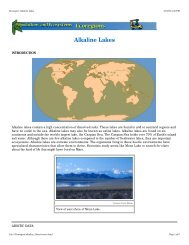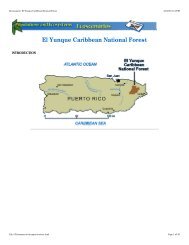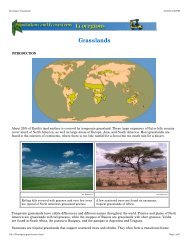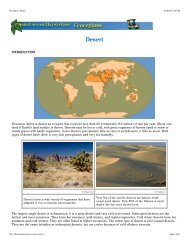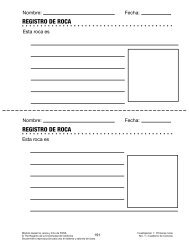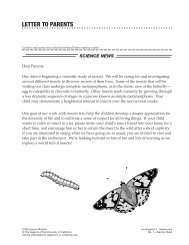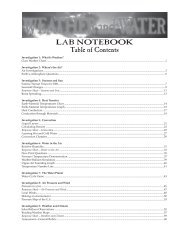Ecoscenarios Combined - FOSSweb
Ecoscenarios Combined - FOSSweb
Ecoscenarios Combined - FOSSweb
Create successful ePaper yourself
Turn your PDF publications into a flip-book with our unique Google optimized e-Paper software.
Ecoscenario: Cimarron National Grasslands<br />
4/16/03 3:09 PM<br />
DEBATE: Should fires be permitted to burn in natural areas like Cimarron National Grassland?<br />
People who support using prescribed fires to improve grassland<br />
Ross W. Gorte, specialist in natural resources policy, Environment and Natural Resources Policy Division, CRS<br />
Report for Congress, Forest Fires and Forest Health<br />
"Following the Yellowstone fires in 1988, however, the use of prescribed natural fire was halted. While one can<br />
question whether the prescriptions were sufficiently responsive to burning conditions (fuel moisture, precipitation,<br />
dry lightning, winds, etc.), the termination of prescribed natural fire policies may have been an overreaction to the<br />
public sentiment."<br />
http://www.cnie.org/nle/crsreports/forests/for-23.cfm<br />
U.S. Department of Agriculture Forest Service, Fire and Aviation Management<br />
"Fire has helped shape North America's wild areas for thousands of years—its presence is essential for the survival<br />
of many plants and animals. We've learned that the lack of periodic fire in many wild areas increases risks to<br />
society and the environment. Much of the danger of destructive fire can be reduced through the increased<br />
application of prescribed fire and the planned use of wildland fire."<br />
http://www.fs.fed.us/fire/fireuse/rxfire/ecology/index.html<br />
George Wuerthner, Smokey the Bear's Legacy on the West<br />
"No single human modification of the environment has had more pervasive and widespread negative consequences<br />
for the ecological integrity of North America than the suppression of fire. Fire suppression has destroyed the natural<br />
balance of the land more than overgrazing, logging, or the elimination of predators."<br />
http://www.fire-ecology.org/research/smokey_bear_legacy.htm<br />
U.S. Geological Survey Northern Prairie Wildlife Research Center, Effects of Fire in the Northern Great Plains:<br />
Effects of Fire on Upland Grasses and Forbs<br />
"One of the simplest and least expensive practices to improve poor quality grassland is prescribed burning."<br />
http://www.npwrc.usgs.gov/resource/2000/FIRE/GRASFORB.HTM<br />
Douglas H. Johnson, U.S. Geological Survey Northern Prairie Wildlife Research Center: Effects of Fire on Bird<br />
Populations in Mixed-Grass Prairie: A Proposed Conservation Strategy<br />
"Results presented here suggest a conservation strategy for the northern Great Plains involving prescribed burning.<br />
On large areas, such as wildlife refuges, only portions should be burned in any particular year, and these on a<br />
rotational basis. The same prescription would apply to smaller areas that can be considered as components in a<br />
landscape, such as waterfowl production areas. They should be burned periodically, but not all in the same year.<br />
That strategy will assure that in any given year habitats in a variety of successional stages will be available for a<br />
variety of breeding bird species.<br />
"Although true grassland birds suffer short-term habitat losses from a burn, they do require grassland, which in turn<br />
requires periodic fire for maintenance. Several of these species have suffered long-term population declines.<br />
Moreover, they typically do not attain high densities or reproduce successfully in habitats other than grassland, as<br />
do birds in the other two categories. Furthermore, these species generally have breeding distributions centered in<br />
the grasslands of the midcontinent."<br />
http://www.npwrc.usgs.gov/resource/1999/firebird/conserve.htm<br />
U.S. Forest Service ranger<br />
"Many plants are adapted to fire. Some plants have seeds that can only germinate after a fire, either because they<br />
need to be heated or because there is something in the smoke the triggers that response. Fires also kill shrubs and<br />
small trees that start to appear in grasslands in the absence of fire."<br />
U.S. Department of Agriculture Forest Service, Historic Fire Regimes<br />
http://www.fs.fed.us/r4/curlew/Caribou_main/Caribou/forest_plan/Deis/Chapter3/fire_management/<br />
chapter_3_fire_historic_fire_regimes.htm<br />
People who are opposed to using prescribed fires in grasslands<br />
Resident near a proposed burn area<br />
"Look at what happened near Lewiston, California, on July 2, 1999. Even when fire personnel are there to watch the<br />
file:///Ecoscenario/cimarron/content.html<br />
Page 10 of 12



